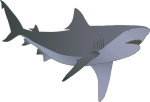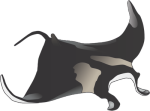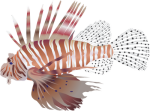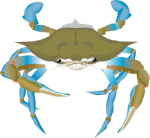Top ten fish and shellfish symbols: Sharks, rays, fish, crabs and lobster larvae
Bill Dennison ·This is the second blog post in a series which celebrates the IAN symbol library by highlighting some of the most interesting symbols. The first blog was top ten marine flora, since this was the focus of the Marine Botany group at the University of Queensland who began drawing vector symbols. The logical next group of symbols, depicted here, are some of the marine animals that live in and around marine flora.
 1) The bull shark (Carcharhinus leucas) is a 'charismatic megafauna', instantly recognizable as a dangerous and majestic animal. The bull shark is one of the deadliest sharks in the world, along the great white and tiger sharks. One of the reasons that this species accounts for so many attacks on humans is its propensity to swim in estuaries and nearshore turbid waters where swimmers are often found. The Brisbane River in Southeast Queensland has thousands of bull sharks, for example, and the historical riverside swimming baths were designed to protect swimmers from shark attacks. I enjoyed scuba diving at Heron Island in the channel between Heron and Wistari Reefs on 'The Patch' and watching large bull sharks loom up from the ocean depths, head straight toward us as we backed into the reef and then turn to the side and slowly swim away as our throbbing heart rates eased. This symbol drawn by Tracey Saxby does a great job of capturing an aggressive pose by a bull shark.
1) The bull shark (Carcharhinus leucas) is a 'charismatic megafauna', instantly recognizable as a dangerous and majestic animal. The bull shark is one of the deadliest sharks in the world, along the great white and tiger sharks. One of the reasons that this species accounts for so many attacks on humans is its propensity to swim in estuaries and nearshore turbid waters where swimmers are often found. The Brisbane River in Southeast Queensland has thousands of bull sharks, for example, and the historical riverside swimming baths were designed to protect swimmers from shark attacks. I enjoyed scuba diving at Heron Island in the channel between Heron and Wistari Reefs on 'The Patch' and watching large bull sharks loom up from the ocean depths, head straight toward us as we backed into the reef and then turn to the side and slowly swim away as our throbbing heart rates eased. This symbol drawn by Tracey Saxby does a great job of capturing an aggressive pose by a bull shark.
 2) The manta ray (Manta birostris) is another 'charismatic megafauna' that inspires awe and wonder when sighted underwater. I love swimming near these graceful creatures, especially if you are lucky enough to be underneath a manta swimming overhead. Their incredible size literally blots out the sun and they often travel in pairs or small groups. Watching them 'fly' through the water by slowly undulating their wings is quite special. Tracey Saxby drew this symbol, likely inspired by her visits to Heron Island where she conducted her Honours degree research.
2) The manta ray (Manta birostris) is another 'charismatic megafauna' that inspires awe and wonder when sighted underwater. I love swimming near these graceful creatures, especially if you are lucky enough to be underneath a manta swimming overhead. Their incredible size literally blots out the sun and they often travel in pairs or small groups. Watching them 'fly' through the water by slowly undulating their wings is quite special. Tracey Saxby drew this symbol, likely inspired by her visits to Heron Island where she conducted her Honours degree research.
 3) The common cuttlefish (Sepia officinalis) is a delight to see underwater, pulsing with changing hues as the background color patterns vary. It is found in the Mediterranean Sea, and as the cuttlefish swims over large patches of seagrasses, rocks, and sand, it changes color. These animals grow larger in the Mediterranean (one foot+) than the smaller Pacific Ocean cuttlefish (a few inches long) that I have seen. This symbol, drawn by Tracey Saxby, captures the shimmering beauty of this animal, although it really should be an animated symbol to truly replicate nature.
3) The common cuttlefish (Sepia officinalis) is a delight to see underwater, pulsing with changing hues as the background color patterns vary. It is found in the Mediterranean Sea, and as the cuttlefish swims over large patches of seagrasses, rocks, and sand, it changes color. These animals grow larger in the Mediterranean (one foot+) than the smaller Pacific Ocean cuttlefish (a few inches long) that I have seen. This symbol, drawn by Tracey Saxby, captures the shimmering beauty of this animal, although it really should be an animated symbol to truly replicate nature.
 4) The red lionfish (Pterois volitans) is a beautiful, terrible fish. It is colorful, large and has intricate and attractive fins, yet its spines contain deadly toxins and it is wrecking havoc as an invasive species in Florida and the Caribbean Sea. This symbol, drawn by the two Science Communication interns who were responsible for so many wonderful symbols and uploads to the IAN Image Library, Kim Kareer and Lucy Van Essen-Fishman, is one of the most detailed and accurate symbols in the library. Kim and Lucy created many symbols that ended up in 'Tropical Connections: South Florida's marine environment' before going off to pursue their graduate studies.
4) The red lionfish (Pterois volitans) is a beautiful, terrible fish. It is colorful, large and has intricate and attractive fins, yet its spines contain deadly toxins and it is wrecking havoc as an invasive species in Florida and the Caribbean Sea. This symbol, drawn by the two Science Communication interns who were responsible for so many wonderful symbols and uploads to the IAN Image Library, Kim Kareer and Lucy Van Essen-Fishman, is one of the most detailed and accurate symbols in the library. Kim and Lucy created many symbols that ended up in 'Tropical Connections: South Florida's marine environment' before going off to pursue their graduate studies.
 5) The leafy sea dragon (Phycodurus spp.) is a cryptic species that blends in with the macroalgal fronds that it inhabits. Its golden brown fins waft in the currents and its prehensile pectoral fins grasp the macroalgae. The aptly named leafy sea dragon is found in temperate waters of Australia, often hanging around beneath piers and moorings. This symbol was drawn by Dieter Tracy, a former member of the Marine Botany group at the University of Queensland, who is now turning his artistic talent toward photography in Townsville, Queensland.
5) The leafy sea dragon (Phycodurus spp.) is a cryptic species that blends in with the macroalgal fronds that it inhabits. Its golden brown fins waft in the currents and its prehensile pectoral fins grasp the macroalgae. The aptly named leafy sea dragon is found in temperate waters of Australia, often hanging around beneath piers and moorings. This symbol was drawn by Dieter Tracy, a former member of the Marine Botany group at the University of Queensland, who is now turning his artistic talent toward photography in Townsville, Queensland.
 6) This school of fish captures the sweep of motion and interplay between individual fish during schooling behavior. Rather than just replicating one of the individual fish over and over, this symbol uses different sizes and positions to convey the mass of fishes acting as one unit. A somewhat generic fish was used so that it could represent schools of different fish species. This symbol was a group effort, with Tracey Saxby collaborating with Kim Kareer and Lucy Van Essen-Fishman.
6) This school of fish captures the sweep of motion and interplay between individual fish during schooling behavior. Rather than just replicating one of the individual fish over and over, this symbol uses different sizes and positions to convey the mass of fishes acting as one unit. A somewhat generic fish was used so that it could represent schools of different fish species. This symbol was a group effort, with Tracey Saxby collaborating with Kim Kareer and Lucy Van Essen-Fishman.
 7) The striped surgeon fish (Acanthurus lineatus) is a colorful tropical fish from the Indo-Pacific. It is found on coral reefs, and is territorial and fairly aggressive. I enjoyed seeing these fish on the Great Barrier Reef. These surgeon fish get agitated when you swim too close and begin to dart around frantically. Their lateral stripes shimmer in the flickering underwater light. Joanna Woerner, a Science Communicator who lived in Hawaii to build an educational module on coral reefs and climate change created this beautiful symbol.
7) The striped surgeon fish (Acanthurus lineatus) is a colorful tropical fish from the Indo-Pacific. It is found on coral reefs, and is territorial and fairly aggressive. I enjoyed seeing these fish on the Great Barrier Reef. These surgeon fish get agitated when you swim too close and begin to dart around frantically. Their lateral stripes shimmer in the flickering underwater light. Joanna Woerner, a Science Communicator who lived in Hawaii to build an educational module on coral reefs and climate change created this beautiful symbol.
 8) The genus and species name of the blue crab (Callinectes sapidus) literally translates to 'Beautiful Swimmer; delectable', which accurately captures the essential features of this icon of Chesapeake Bay. The IAN Symbol Library has many versions and life stages of the blue crab, but this adult male crab symbol (aka, Jimmy) resonates with me, because this is the most common one that we catch and eat in the Maryland portion of Chesapeake Bay. This symbol was drawn by Chip Chenery from the Chesapeake Biological Laboratory.
8) The genus and species name of the blue crab (Callinectes sapidus) literally translates to 'Beautiful Swimmer; delectable', which accurately captures the essential features of this icon of Chesapeake Bay. The IAN Symbol Library has many versions and life stages of the blue crab, but this adult male crab symbol (aka, Jimmy) resonates with me, because this is the most common one that we catch and eat in the Maryland portion of Chesapeake Bay. This symbol was drawn by Chip Chenery from the Chesapeake Biological Laboratory.
 9) The male mangrove fiddler crab (Uca annulipes) is a comical little creature, waving his big claw (propodus) around to show off to female crabs. These little crabs live right at the land-sea interface in salt marshes and mangroves, climbing out of the water and scuttling down little holes in the sediments when frightened. Sometimes a whole group of little guys (both left handed and right handed) will stand up waving their claws at you to warn you off. This symbol, created by Kim Kareer and Lucy Van Essen-Fishman shows a left handed male fiddler crab from the East coast of Africa.
9) The male mangrove fiddler crab (Uca annulipes) is a comical little creature, waving his big claw (propodus) around to show off to female crabs. These little crabs live right at the land-sea interface in salt marshes and mangroves, climbing out of the water and scuttling down little holes in the sediments when frightened. Sometimes a whole group of little guys (both left handed and right handed) will stand up waving their claws at you to warn you off. This symbol, created by Kim Kareer and Lucy Van Essen-Fishman shows a left handed male fiddler crab from the East coast of Africa.
 10) The spiny lobster (Panulirus argus) has a larval stage that floats in surface waters of the ocean and looks nothing like the adult stage. The name of the larval stage is 'phyllosoma', and early naturalists did not make the connection between this translucent, soft and flattened organism with the hard, spiny rounded adult. I first encountered a phyllosoma as a sea semester student aboard the R/V Westward with the Sea Education Association. I was staggered at the intricate beauty and was incredulous that it was the same species as the adult spiny lobster. This symbol was drawn by Tracey Saxby who used a soft blue to convey the translucent coloring.
10) The spiny lobster (Panulirus argus) has a larval stage that floats in surface waters of the ocean and looks nothing like the adult stage. The name of the larval stage is 'phyllosoma', and early naturalists did not make the connection between this translucent, soft and flattened organism with the hard, spiny rounded adult. I first encountered a phyllosoma as a sea semester student aboard the R/V Westward with the Sea Education Association. I was staggered at the intricate beauty and was incredulous that it was the same species as the adult spiny lobster. This symbol was drawn by Tracey Saxby who used a soft blue to convey the translucent coloring.
About the author
Bill Dennison

Dr. Bill Dennison is a Professor of Marine Science and Vice President for Science Application at the University of Maryland Center for Environmental Science.

